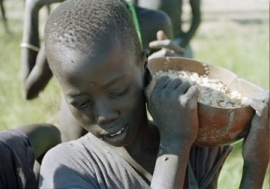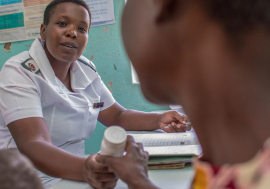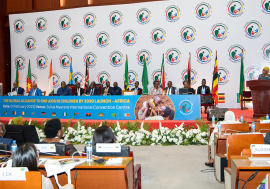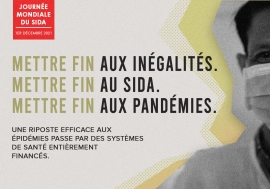A grim prognosis for AIDS in Africa
A grim prognosis for AIDS in Africa
From Africa Recovery, Vol.16 #2-3 (September 2002), page 7 AIDS pandemic in sub-Saharan Africa, 2001('000 people) Africa World Total HIV infections 28,500 40,000 Total deaths 2,200 3,000 New infections 3,500 5,000 Children (0-14) with HIV 2,600 3,000 Child deaths (high estimate) 650 720 AIDS orphans 11,000 14,000 Access to anti-retroviral drugs 30 730 Source: UN Africa Recovery from UNAIDS data. A grim prognosis for AIDS in AfricaDisease slows in a few countries, but spreads more rapidly elsewhereBy Michael FleshmanAmid signs that the world is finally waking up to the global threat of HIV/AIDS, the disease continued its rampage through sub-Saharan Africa last year, taking an additional 2.2 million lives and infecting 3.5 million more people. That brought the estimate of the total number of Africans thought to be infected with the deadly HIV virus, which destroys the body's natural ability to fight disease, to 28.5 million at the end of 2001, or 70 per cent of the global total. Only 30,000 of these are thought to have access to the anti-retroviral medications that have dramatically reduced AIDS deaths in developed countries.The new statistics, contained in the Joint UN Programme on HIV/AIDS (UNAIDS) 2002 Report on the Global HIV/AIDS Epidemic (www.unaids.org), dashed hopes by some analysts that AIDS had reached its "natural limit" in Africa and that the rate of new infections would begin to level off without the need for costly new prevention and treatment programmes. On the contrary, the disease now appears poised to spread more widely in West and Central African countries previously spared the double-digit infection rates that have devastated Southern and East Africa. Cameroon, which recorded an adult infection rate of 4.7 per cent among urban-dwellers in 1996, saw that figure more than double to 11.8 per cent in 2001. In neighbouring Nigeria, Africa's most populous country, the overall infection rate stood at 5.8 per cent. But rates were as high as 11 and 12 per cent in some regions, and the number of Nigerians carrying the virus, 3.5 million, trails only South Africa as the largest in the world.The situation is no better in Asia and Eastern Europe, researchers say, where the disease also appears ready for explosive growth. "These data demonstrate that HIV/AIDS is spreading rapidly in parts of the world where the epidemic seemed stable or was previously confined to groups at highest risk of infection," UNAIDS Executive Director Peter Piot told reporters. Without a dramatic increase in anti-AIDS efforts, he cautioned, the pandemic could take an additional 68 million lives by the year 2020 -- 55 million of them in Africa alone.Despite significant increases in funding for AIDS programmes in low- and middle-income countries over the past four years, the $3 bn currently available is less than a third of the $10 bn health officials agree is needed annually for a "credible" global response to the disease. "It is now clear that the AIDS epidemic is still in its early stages," Dr. Piot asserted. "And let's be equally clear: our fightback is at an even earlier stage."Crisis deepens2001 saw AIDS further tighten its deadly grip on Southern Africa, already the epicentre of the global epidemic. All seven countries with adult infection rates above 20 per cent are in the region, including Botswana, with a 38.8 per cent infection rate, and Zimbabwe, where one in three adults is HIV-positive. Even these alarming figures, however, mask the full impact of the disease on particularly vulnerable populations. Among pregnant women in urban Botswana for example, infection rates that exceeded 38 per cent in 1997 had risen to almost 45 per cent by the end of last year. In the 25-29 age group, infection rates topped 55 per cent.The extraordinarily high rates among women in their prime child-bearing years have the gravest implications for their children, many of whom will become infected by their mothers or be orphaned as their parents die. Significantly, about half of all new adult infections are occurring among young adults aged 15-24. This is evidence, Dr. Piot told reporters, that despite two decades of HIV/AIDS education and prevention programmes, "young people do not have the information and means to protect themselves from HIV."That is particularly true for women, who accounted for almost 60 per cent of all new infections in Africa during 2001. A recent study of young people and HIV/AIDS by UNAIDS, the UN Children's Fund (UNICEF) and the World Health Organization (WHO) found that four out of five young women in Cameroon, the Central African Republic, Equatorial Guinea, Lesotho and Sierra Leone lacked the information needed to protect themselves from the disease. "The tragic consequence," noted UNICEF Executive Director Carol Bellamy, "is that they are disproportionately falling prey to HIV."The development implications of AIDS in the worst-affected countries is only beginning to be understood. Addressing delegates at the opening of the 14th International Conference on AIDS in Barcelona on 8 July, Dr. Bernhard Schwartlander, the director of WHO's HIV/AIDS department, predicted that 25 per cent of the workforce in severely affected countries would die of AIDS-related illnesses by 2020, undermining the New Partnership for Africa's Development (NEPAD) and crippling economic growth and poverty-reduction efforts. A 1999 WHO study of the impact of AIDS on agricultural production in Zimbabwe found that rural households with one AIDS death suffered a 61 per cent drop in production of the staple food crop, maize, and a 49 per cent reduction in vegetables. The disease now appears poised to spread more widely in West and Central African countries previously spared the double-digit infection rates that have devastated Southern and Eastern Africa. AIDS already accounts for 75 per cent of deaths among Kenyan police and is expected to take the lives of 7,000 teachers in Malawi by the end of the next decade, Dr. Schwartlander noted. In Gaborone and Francistown, he told delegates, "every second or third person sitting on a bus or walking on the street is HIV-positive. It is almost impossible for me to get my mind around these figures."An official with the US government's Census Bureau, Ms. Karen Stanecki, told reporters in Barcelona that under the agency's "middle-case scenario," life expectancy in Botswana and Mozambique would drop from 46 in 1999 to just 27 years by the end of this decade, and below 40 in nine other African countries. Should such estimates prove accurate, the number of AIDS orphans in Africa is expected to soar from 11 million to 20 million by the year 2020. "HIV/AIDS is rolling back decades of development progress in Africa," Dr. Piot observed. "Every element of African society, from teachers to soldiers to farmers, is under attack."New 'paradigm,' old problemsDespite the bad news, UNAIDS officials argue that there has been a "paradigm shift" in international awareness of the AIDS threat to economic growth and stability. "In the past two years the world has awakened to the AIDS epidemic and what it takes to bring it under control," Dr. Piot asserted. "We are entering a new era in the worldwide response to AIDS." Health officials point to four key reasons for optimism, including:
- greatly increased political leadership in the fight against AIDS
- a six-fold increase in funding for education and prevention programmes in developing countries since 1998
- a dramatic drop in AIDS drugs prices, including life-saving anti-retroviral medicines
- success by some developing countries in reducing infection rates through mass mobilization and public education campaigns.
Uganda continues to prove that education and prevention programmes, well designed, adequately funded and backed by strong political leadership, can reverse the epidemic in developing countries. Last year national infections dropped to just 5 per cent of adults from 8.3 per cent in 1999, and from double-digit rates in the early 1990s. Botswana became the first African country to announce plans to provide all citizens with access to AIDS education, testing and counselling and treatment services, including anti-retroviral drugs, launching the programme at the beginning of this year (see "Botswana's high-stakes assault on AIDS").In Zambia, a concerted education and prevention campaign targeting women has reduced infection rates among young women in the cities from 28.3 per cent in 1996 to 24.1 per cent, with a similar drop in infection rates among young rural women. A campaign to promote condom use among prostitutes in Abidjan produced even more dramatic results, with infections dropping from 89 per cent in 1991 to 32 per cent in 1998.Business as usual or 'never again?'But in Africa and other poor regions in 2001, successful AIDS programmes continued to be the exception instead of the rule. Despite the launch of some 100 national aids coordinating bodies around the world, many governments and civil society groups struggled to strengthen political leadership, design effective action plans and, most importantly, overcome the desperate shortage of human and material resources. Donors and non-governmental activists remain at loggerheads over funding priorities, drug patent rights and the feasibility of treating the tens of millions of HIV-positive people in developing countries.In South Africa, a dispute with activists over whether the state health service is required to provide pregnant women with drugs that reduce mother-to-child transmission of HIV went all the way to the Constitutional Court before being resolved in favour of treatment advocates. Botswana's ambitious plan to provide full treatment to people living with AIDS has been hampered by widespread fear of stigmatization and the absence of trained personnel, clinical and laboratory facilities and testing and counselling services.But it is the continuing shortfall in international funding for the battle against AIDS in Africa and other poor regions that has attracted the harshest criticism from non-governmental organizations (NGOs) and international health experts. While critics have welcomed the recent increase in aid to developing countries, they charge that the failure to fully fund AIDS programmes in poor countries has needlessly taken millions of lives, and that tens of millions more will die unless adequate resources are provided.Despite the highly publicized launch last year of the global AIDS fund, it has raised just $2 bn -- well short of the amount UN officials expected. Because much of that money has come in the form of multi-year grants, said Mr. Stephen Lewis, the Secretary-General's special emissary for AIDS in Africa, the fund to date has raised just 7 per cent of its target.On the eve of the Barcelona conference, two prominent Northern NGOs, Doctors Without Borders and the Health Gap Coalition, accused wealthy countries of "wilful neglect" for refusing to adequately fund treatment programmes in Africa. "The refusal of the European Union and other donor governments to commit funds for lowest-cost medicines has already condemned millions to death," charged Health Gap founder Dr. Alan Berkman. "The feasibility of treatment has never been more certain. But as long as wealthy countries refuse to pay, feasibility does not matter." Health Gap members staged a series of noisy protests at the conference, occupying drug company exhibits, demanding greater action from the private sector and disrupting an address by the US health minister, Mr. Tommy Thompson.The time for promises, Dr. Piot announced in Barcelona, is over. "We have moved beyond the point where world leaders have ignored our pleas. The promises have been made. Now, they need to be kept." In a speech notable for its toughness, the normally diplomatic UNAIDS head charged that political leaders in Africa and the world stood and watched while millions of Africans died needlessly. "We cannot stand by as passive observers while other continents repeat history, and we must not fail Africa now, in her attempts to turn back the epidemic's devastation.... The world stood by while AIDS overwhelmed sub-Saharan Africa. Never again."






















